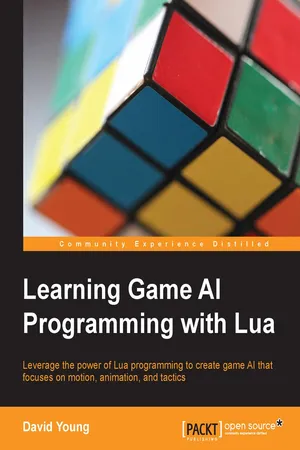![]()
Learning Game AI Programming with Lua
![]()
Table of Contents
Learning Game AI Programming with Lua
Credits
About the Author
About the Reviewers
www.PacktPub.com
Support files, eBooks, discount offers, and more
Why subscribe?
Free access for Packt account holders
Preface
What this book covers
What you need for this book
Who this book is for
Conventions
Reader feedback
Customer support
Downloading the example code
Downloading the color images of this book
Errata
Piracy
Questions
1. Getting Started with AI Sandbox
Introduction to AI sandbox
Understanding the sandbox
The project layout
The Premake build
Compiling the sandbox with Visual Studio 2008/2010/2012/2013
Open source libraries
Open source tools
Lua IDE – Decoda
Running AI sandbox inside Decoda
Setting up a new Decoda project
Debugging Lua scripts
Decoda Watch window
Decoda Call Stack window
The Decoda Virtual Machines window
Simultaneous Lua and C++ debugging
Visual Studio – Attach to Process
Decoda – Attach to Process
Decoda – Attach System Debugger
Associating Lua scripts from code with Decoda
The Lua virtual machine
The Lua stack
Lua primitives
Metatables
Metamethods
Userdata
C/C++ calling Lua functions
Lua calling C/C++ functions
Function binding
Creating custom userdata
Looking at the vector data type
The demo framework
Ogre
Object-Oriented Input System
SandboxApplication
Sandbox
Agent
Utility classes
Lua binding
Summary
2. Creating and Moving Agents
Creating a new sandbox project
Setting up the file structure
Extending the SandboxApplication class
Running your sandbox for the first time
Creating a new Decoda project
Configuring Decoda's run executable
Creating a sandbox Lua script
Creating a floor
Adding a light
Adding a skybox
Adding meshes to the sandbox
Creating sandbox objects
Shooting blocks
Creating an agent Lua script
Creating a visual representation
Updating an agent position
Updating an agent orientation
Agent properties
Orientation
The forward axis
The left axis
The up axis
Location
Position
Size
Height
Radius
Physics
Mass
The max force
The max speed
Speed
Velocity
Knowledge
Target
Target radius
Path
Agents' movement
Mass
Speed
Velocity
Acceleration
Force
Agent-steering forces
Seeking
Applying steering forces to an agent
Clamping the horizontal speed of an agent
Creating a seeking agent
Pursuit
Fleeing
Evasion
Wandering
The target speed
Path following
Creating a path following agent
Avoidance
Collision avoidance
Obstacle avoidance
Avoiding blocks and agents
Group steering
Alignment
Cohesion
Separation
Creating a group of followers
Summing steering forces
Weighted sums
Priority-based forces
Summary
3. Character Animations
Skeletons and meshes
Mesh skeletons
Loading an animated mesh
Showing a skeleton
Attaching meshes to bones
Attaching a weapon to our soldier
Animation clips
Playing an animation on our soldier
Soldier animations
Crouching animations
Standing animations
Weapon animations
Soldier poses
Weapon poses
Manipulating animations
Enabling and disabling animations
Looping animations
The animation length
The animation time
Normalized time
Restarting an animation
Playing a non-looping animation
The animation rate
Animation blending
Animation weights
Blend window
Blend curves
Linear blending
Playing with blend weights
Animation state machine (ASM)
States
Transitions
Creating animation state machines
Creating helper functions
Adding states
Adding transitions
Adding external helper functions
Forcefully setting states
Requesting states
Updating the animation state machine
Handling state transitions and state requests
Updating running animations
Adding functions to animation state machine instances
Building a weapon animation state machine
Building a soldier animation state machine
Updating animation state machines
Playing with states
Summary
4. Mind Body Control
Creating a body
Creating a soldier
Attaching an animated mesh to an agent
Creating an obstacle course
Displaying the physics world
Adding callbacks to the animation state machine
Handling callbacks
Adding callbacks to the ASM
Updating the ASM to call callbacks
Getting our soldier to shoot
The bone position
The bone rotation
Creating particle effects
The particle direction
Object removal
The collision impact callback
Shooting a projectile
Handling projectile collision impacts
Shooting
Getting our soldier to run
Setting a path through the obstacle course
Running the obstacle course
Creating a brain
Approaches for mind body control
Direct animation control
The death state
The idle state
The falling state
The moving state
The shooting state
A simple, finite state machine
Initializing the agent
Agent FSM state handling
Indirect animation control
The animation controller
Commands
The command queue
Manipulating commands
The change stance command
The die command
The fall command
The idle command
The move command
The shoot command
Assigning member functions
Initializing the controller
Adding handlers for commands
Updating the controller
Running the obstacle course
Creating a direct control agent
Creating an indirect control agent
Indirect control agent initialization
Indirect control agent update
Indirect control agent control
Spawning an indirect control agent
Action latency
Summary
5. Navigation
Pathfinding
Creating a navigation mesh
Configuring navigation meshes
The walkable height
The walkable radius
The walkable climb height
The walkable slope angle
The minimum region area
Building the navigation mesh
Drawing the navigation mesh
Pathfinding on a navigation mesh
Path query
Query results
Random navigation points
The path information
Adding random pathfinding to our soldier
Updating agent paths
Drawing paths
Initializing the navmesh
Randomly running agents
Creating addition...
